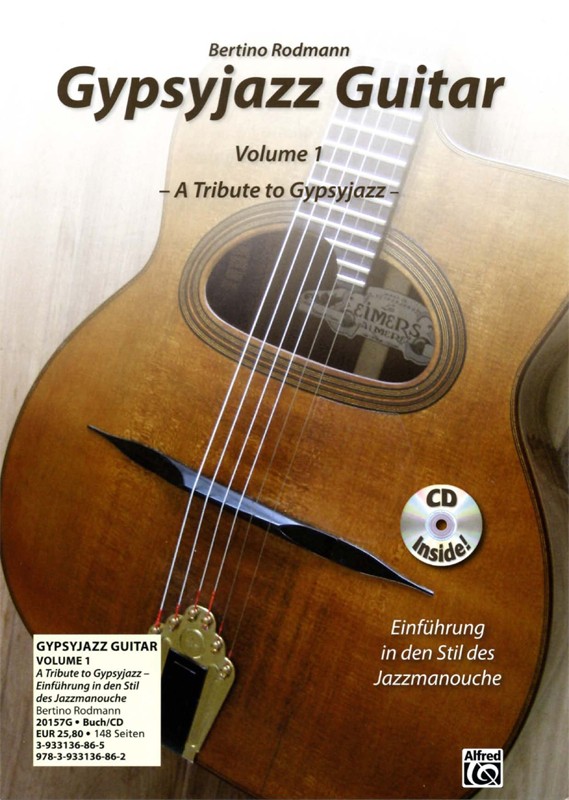Solotechnique of Gypsyjazz
The Solotechnique of Gypsyjazz for improvising and playing solos in the style of Jazz-Manouche (or Gypsyjazz) has, like many things in this style, been strongly influenced by Django Reinhardt – the Guitar-Maestro, the grandmaster and great pioneer of this music.
As already briefly described in the articles “Play-technique of Gypsyjazz” and “Django Reinhardt – the Guitar-Maestro”, Django Reinhardt had this very heavy accident at the age of 18, at which his left bodyside was completely burnt in third degree

Due to this “disability” that was left over by that, his left hand was strongly injured by these burnings (see photo left), thus he wasn´t able anymore to use his pinky and ringfinger very well, mainly for chordplaying but for soloing as well. So that kind of disablity led him to develop different techniques to play guitar again without pain, thus resulting in somewhat strange fingerings for playing chords as well as his style of soloplaying. So this has great affect on the way things are played in this music-style.
But also one of the other main differences of the style in comparison to other guitarstyles was (and still is) the picking-technique beeing used by Django and all other Gypsyplayers of his heritage (like Bireli Lagrene or Stochelo Rosenberg).
Usually guitarrists that play other styles of music like Blues, Rock or Pop normally are used to play the so called “Alternate Picking”.
This picking-technique utilizes the plectrum just beeing played with up- and down-strokes wether if there is a string-change or not (see example 1, an extract from my book “Gypsyjazz Guitar” which has been released in 2011 and 2013 also in english).
In the following sheet-example (image below) you clearly see that, even while playing a string-change there s no change of striking with the pick, thus playing Alternate-picking you just stay at playing up-down-up-down etc.

When playing Gypsyjazz you will have to use a complete different picking-technique, which is the so called “Rest-Stroke”-picking.
The “Rest-Stroke”-picking is a picking-technique which derivates from the classical “Apoyando”-playing, just utilized for playing with plectrum:

The Apoyando-picking (spanish = “to attach, to stop at“) means attaching the finger to the next following string after playing one string. That means if you played a string with a finger, this finger “attaches” e.g. “rests” on the next following string (down or upward) after plucking the string.
The “Rest-Stroke”-picking in Gypsyjazz is this picking-technique that has just been derivated from this classical playing-technique, transfered on playing with a pick. Here you will hit the string with your pick and “rest” on the next following string with the pick (instead of a finger) without leaving it, therefore “rest-stroke”.
And the more the “Rest-Stroke”-Picking which is utilized in Gypsyjazz has yet another consequent quality of use: while changing strings with the pick you will almost always use a “DOWN“-Stroke even by changing strings (see example 2).
So the “rest-stroke”-playing is one of the reasons why a lot of Gypsy-players often have an incredible and extremly exact kind of playing when soloing, as it dramatically reduces errors while playing. And additionally gives you a very straight and powerful tone.
Also very much influenced by great master Django Reinhardt and his remarkable style of playing are the scales, licks and/or arpeggios that are utilized in JazzManouche.
Django, while trying to rehearse back to his old playing-ability recovering in hospital after his heavy accident, pretty soon realized that he could play many fast notes and lots of impressing single-note-runs by using arpeggios (so called “disassembled chords”) while soloing with ease.

This may be one of the reasons why Django used these so extensively in his solos, as he might have been playing eight-notes very fast and easyly and long without any pain in comparison to general scales which may still have hurt him.
Here´s an example of a very easy arpeggio in A-minor, based on a straight Barré-chord played at the fifth fret:

If you like to know more about the soloing in Gypsyjazz or want to learn this technique you may inform yourself about my “Masterclass for Gypsyjazzguitar”, in which i show my students the techniques for Rhythm-, picking- and Soloplaying with lots of examples.
Or if you better like to work on your own (or cannot come to my masterclasses as it is too far for you) you may order my methodbook “Gypsyjazz Guitar” released by Alfred Verlag (Köln), available at Amazon.de or here on this website. This book also includes some of these examples and step-by-step-practises to learn these play-technologies of JazzManouche.
Get into it and keep up the swing!
ADVERTISING
 “Gypsyjazz Guitar – a tribute to Gypsyjazz“
“Gypsyjazz Guitar – a tribute to Gypsyjazz“
Gypsy-Jazz bzw. Jazz-Manouche ist der erste in Europa entstandene Jazzstil.
Seine Einflüsse kommen aus dem französischen Musette-Walzer, dem ungarischen Çsardas oder dem spanischen Flamenco, sowie der Sinti-Musik selbst, die von den Sinti-Musikern in Swing-Phrasierung interpretiert wurde.
Ziel des Buches: Nicht nur eine umfassende Gitarrenschule für Gypsy-Jazz Gitarre zu verfassen, die die rhythmischen und solistischen Aspekte der Gypsyjazz Gitarren-Spielweise vermittelt, sondern auch den Respekt gegenüber der uralten Tradition der Sinti.
Inhalt Teil 1: Rhythm Guitar: Comping, La Pompe-Rhythmus, Dead Notes, Gypsychords, Voicings, Blues-Kadenz, Chord Substitution
Inhalt Teil 2: Solo Guitar: Reststroke Picking, Arpeggio Picking, Sweptstroke Picking, Skalen, Arpeggien, Solo Licks
Verlag: Alfred Music Publishing GmbH; Auflage: 1 (15. Oktober 2011)
Sprachen: Deutsch / English ISBN-10: 3933136865 – ISBN-13: 978-3933136862
148 Seiten, mit Play-alongs und Noten & Tabulatur + Audio-CD Preis: 25,80
Erhältlich bei Amazon, Alfred Verlag oder www.bertino-guitarrist.com
Share this article:
